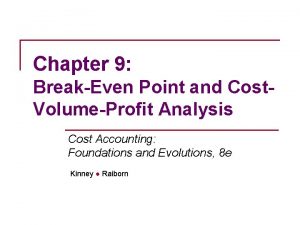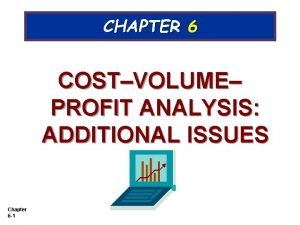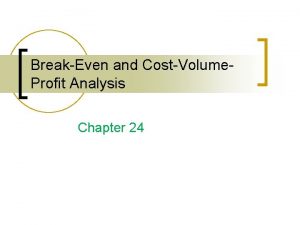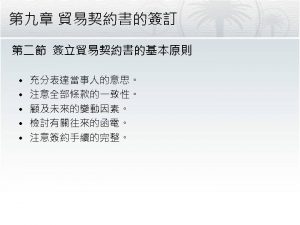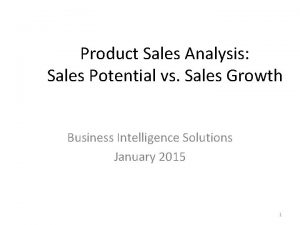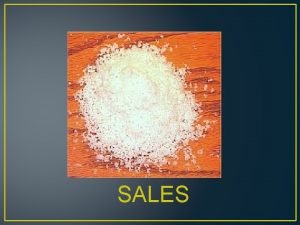Dollars for Dollars Comparing Sales Data and Research





















- Slides: 21

Dollars for Dollars – Comparing Sales Data and Research Funding in U. S. Ag and Food Systems James A. Sterns Associate Professor Department of Applied Economics WERA-72 Annual Meeting July 1, 2014 Santa Clara University, CA

Hot topics in Agricultural & Food Marketing • Product Differentiation and Niche Marketing of agricultural and food products • Direct Marketing of agricultural and food products (a. k. a. , short food supply chains, alternative food networks, local food systems) 1 January 14, 2022

Basic Questions – Can anyone tell me… …for each product differentiation strategy, • How much R&D investments have been made? • What are, to date, the market outcomes of the strategy? …for each direct marketing strategy, • How much R&D investments have been made? • What are, to date, the market outcomes of the strategy? 2 January 14, 2022

Before we answer those questions…a few issues to be considered • Fads? Or something more? • When do we reach tipping points? • At what point do we acknowledge Fundamental Changes in Market Structure? • Is anecdotal evidence enough? • Fulton, Mississippi Walmart rule • My drive from Florida to Oregon – black cows coast to coast • EU shift in CAP – incentives to adopt strategies 3 January 14, 2022

Before we answer those questions…a few issues to be considered • Beyond anecdotal, is there market data? • Consumer survey data – WTP, Experimental Auctions, Reported/recall purchase data • Sales Data – dollars sold • Sales Data – relative to overall market sales; market shares • Growth trends, adoption rates • Forecasted sales potential over time 4 January 14, 2022

Before we answer those questions…a few issues to be considered • Beyond market data? • Niche or special clients served – Whose preferences get met? Whose preferences get ignored? • Externalities and Broader Impacts – Who bears which costs? Who captures which benefits? • Choices article by Lamie, et al. , 4 th Quarter 2013 – Impacts on health, , the environment, food security, social capital, and economic well-being 5 January 14, 2022

Scope and limitations of this paper • Move beyond anecdotal evidence • Focus on sales, market share and proxies for research and development efforts • Leave for future research – broader impacts on preferences met, costs borne and benefits gained 6 January 14, 2022

Scope and limitations of this paper • Issues • Which strategies? • What proxies? • Secondary Market Research • A. C. Nielsen’s list of 75 functional food claims • Consumer Reports 140 labels and general claims about foods • Institute of Food Technologists “top ten” functional food trends (2014, 2012) • Review of Ag Econ Search database of publications • NIFA/CRIS projects by subject of investigation and/or knowledge area classification 7 January 14, 2022

Findings – Needles in Haystacks • Organics – Market Outcomes • USDA’s 2012 Ag Census • 14, 326 organic farms • 2, 109, 303 total number of farms • Organic farms are 0. 67% of all farms • Total organic product sales = $3. 12 Billion • Total market value of ag products sold = $394. 64 Billion • Organic product sales are 0. 79% of market value of ag products sold 8 January 14, 2022

Findings – Needles in Haystacks • Organics – Market Outcomes • Organic Trade Association, 2011 Organic Industry Survey • U. S. sales of organic food and beverages have grown from $1 billion in 1990 to $26. 7 billion in 2010. Sales in 2010 represented 7. 7 percent growth over 2009 sales. • Organic food and beverage sales represented approximately 4 percent of overall food and beverage sales in 2010. Leading were organic fruits and vegetables, now representing over 11 percent of all U. S. fruit and vegetable sales [suggesting aprox. $4 Billion in organic f&v sales]. 9 January 14, 2022

Findings – Needles in Haystacks • Organics – Market Outcomes • IBISWorld Fruit & Vegetable Markets in the US Report (2014) “The continued focus on health and organic foods is anticipated to drive the industry over the five years to 2019, with revenue increasing at a forecast annualized rate of 1. 1% to $4. 9 Billion. ” • S&P (2014) – “With nearly 40% of consumers purchasing items labeled organic, most consumers who buy natural and organic products are doing so in their primary supermarket. ” 10 January 14, 2022

Findings – Needles in Haystacks • Organics – Market Outcomes • FMI (2012) – “ 30% of consumers are willing to pay more for organic products. ” • Packaged Facts (2013) – • $39. 4 billions in sales of foods and beverages • 31% adults are regular organic users • Consumer Reports (2014) – Nationally representative sample of 1, 016 adult U. S. residents. 18% buy food labeled organic every week 18% buy food labeled organic 2 -3 times per month 9% buy food labeled organic once a month Total = 54% of respondents buy at least once per month! 11 January 14, 2022

Findings – Needles in Haystacks • Organics – R&D Investments • NIFA/CRIS Database (by “knowledge area” and “subject of investigation”) • From 2007 through 2011, $855 K projects specific to organics, plus an additional $1. 064 million on projects with some focus on organics. • From 2007 through 2011, total funding for all projects in knowledge areas 601 to 611 = $934 million; 0. 21% went to marketing research on organic agricultural and food products • For period 2007 to present, project key word search for “organic food” identifies 78 past or active projects. 12 January 14, 2022

Findings – Needles in Haystacks • Organics – R&D Investments • Ag Econ Search • Key word search, “organic food” or “organic market”, for years 2007 to present = >1, 000 scholarly works • No other product differentiation strategy generates this quantity of hits, with most other searches generating less than 250 identified scholarly works (and many of these have over-lapping content with “organic”) 13 January 14, 2022

Findings – Needles in Haystacks • Direct Marketing Strategies – Market Outcomes • USDA 2012 Ag Census • 49, 043 farms that “marketed products directly to retail outlets” • 12, 617 farms that “marketed products through community supported agriculture (CSA)” • Total farms in U. S. = 2, 109, 303 • 2. 32% of farms marketing directly to retail outlets • 0. 60% of farms marketing with CSA 14 January 14, 2022

Findings – Needles in Haystacks • Direct Marketing Strategies – Market Outcomes • USDA 2012 Ag Census Data • $1. 3 billion = “value of ag products sold directly to individuals for human consumption; 144, 530 farms • $395 Billion = Total agricultural sales; 2. 11 million farms • 0. 79% of sales; 6. 85% of farms • USDA National Farmers Market Directory (2013) – 8, 144 markets 15 January 14, 2022

Findings – Needles in Haystacks • Direct Marketing Strategies – Market Outcomes • Consumer Reports (2014) • 66% of consumers look for “locally grown” on food labels • 82% want food labels for state of origin • 92% want country-of-origin labeling • FMI (2012) - 48% of consumers report looking for locally sourced products when shopping • S&P (2014) – “local food movement is on the rise with direct to consumer marketing accounting for over $1. 2 billion annually. Farmers markets and CSAs are rising…” 16 January 14, 2022

Findings – Needles in Haystacks • Gluten-free food product • S&P (2014) • $1. 3 billion in sales in 2011 • $1. 68 billion in sales forecasted by 2015 • Nearly 30% of consumers “want to cut down or eliminate gluten from diet • Mintel (2014) – gluten-free label approaching $10. 5 billion in 2013 • Ag Econ Search – zero hits 17 January 14, 2022

Other strategies to add to the study… • • • • U-pick Roadside stands Direct to retailer, direct to schools CSA “local” “natural” GMO-free “animal welfare” (cage-free, pasture-raised) “Hormone-free” Certified Angus Beef COOL State/regional, geographic indicators Corporate Social Responsibility Fair Trade Functional foods (specific traits? ) 18 January 14, 2022

Implications (preliminary) • Progress to Date • Additional Opportunities • Avoidable mis-matches 19 January 14, 2022

Questions and Comments? Contact Information James A. Sterns Department of Applied Economics Oregon State University jasterns@oregonstate. edu 541 -737 -1406 20 January 14, 2022
 Margin of safety formula
Margin of safety formula How to calculate break even point in dollars
How to calculate break even point in dollars Break even income
Break even income Sales organization structure and sales force deployment
Sales organization structure and sales force deployment Discuss the nuances of sales letters.
Discuss the nuances of sales letters. Selling organization
Selling organization Sales territories and sales quotas
Sales territories and sales quotas Sales potential vs sales forecast
Sales potential vs sales forecast Compare box plots worksheet
Compare box plots worksheet Comparing and contrasting hinduism and buddhism
Comparing and contrasting hinduism and buddhism Iso 22301 utbildning
Iso 22301 utbildning Typiska drag för en novell
Typiska drag för en novell Tack för att ni lyssnade bild
Tack för att ni lyssnade bild Ekologiskt fotavtryck
Ekologiskt fotavtryck Varför kallas perioden 1918-1939 för mellankrigstiden?
Varför kallas perioden 1918-1939 för mellankrigstiden? En lathund för arbete med kontinuitetshantering
En lathund för arbete med kontinuitetshantering Särskild löneskatt för pensionskostnader
Särskild löneskatt för pensionskostnader Personlig tidbok fylla i
Personlig tidbok fylla i Anatomi organ reproduksi
Anatomi organ reproduksi Densitet vatten
Densitet vatten Datorkunskap för nybörjare
Datorkunskap för nybörjare Tack för att ni lyssnade bild
Tack för att ni lyssnade bild
